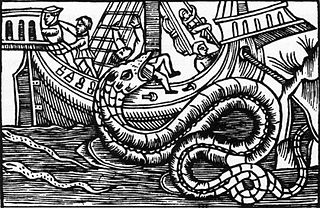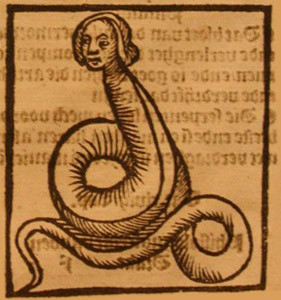
A sea serpent or sea dragon is a type of dragon sea monster described in various mythologies, most notably Mesopotamian (Tiamat), Judaeo-Christian (Leviathan), Greek, and Norse (Jörmungandr).
In Norse mythology, Árvakr and Alsviðr are the horses which pull the sun, or Sól's chariot, across the sky each day. It is said that the gods fixed bellows underneath the two horses' shoulders to help cool them off as they rode.
Apalāla is a water-dwelling Nāga in Buddhist mythology. It is said that Apalāla lived near the Swat River, this area is currently located in Peshawar, Khyber-Pakhtunkhwa Province, Pakistan. He is known to be a Naga King.
Magical creatures are an aspect of the fictional Wizarding World contained in the Harry Potter series and connected media originally created by British author J. K. Rowling. Throughout the seven main books of the series, Harry and his friends encounter many of these creatures on their adventures in Hogwarts, the Forbidden Forest, or other locations throughout the Wizarding World. In addition, students learn to take care of creatures such as hippogriffs and unicorns in the Care of Magical Creatures class at Hogwarts. Rowling has also written Fantastic Beasts and Where to Find Them, a guide to the magical beasts found in the series, and based on the fictional textbook of the same name written by Newt Scamander and used by students at Hogwarts.

The Alkonost is a legendary woman-headed bird in Slavic folklore. Alkonost is more likely an individual character, as was noted in some legends about this bird.

The Kellas cat is a large black cat found in Scotland. It is an interspecific hybrid between the Scottish wildcat and the domestic cat. Once thought to be a mythological wild cat, with its few sightings dismissed as hoaxes, a specimen was killed in a snare by a gamekeeper in 1984 and found to be a hybrid between the Scottish wildcat and domestic cat. It is not a formal cat breed, but a landrace of felid hybrids. It is named after the village of Kellas, Moray, where it was first found. The purported first live cat was caught by the Tomorrows World team and featured in the 1986 programme 'On the Trail of the Big Cat'. The historian Charles Thomas speculated that the Pictish stone at Golspie may depict a Kellas cat. The Golspie stone, now held at the Dunrobin Castle Museum, shows a cat-like creature standing on top of a salmon which may allude to the characteristics ascribed to a Kellas cat of catching fish while swimming in the river.

Nagaraja is a title used to refer to the nagas, the serpent-like figures that appear in Indian religions. It refers to the kings of the various races of the nāga, the divine or semi-divine, half-human, half-serpent beings that reside in the netherworld (Patala), and can occasionally take human form. Rituals devoted to these supernatural beings have been taking place throughout South Asia for at least two thousand years.
Freybug is a monstrous Black Dog that is stated to come from medieval English folklore, specifically from Norfolk. Like most supernatural black dogs, it was roughly the size of a calf, and wandered country roads terrifying travelers.
A legendary creature from Welsh tradition depicted as very large and intelligent birds, often considered to be related to the griffin,

The Hydrus is a creature from Medieval bestiaries. They were said to be found in the Nile River. While in the Nile, a crocodile would roll the hydrus in the mud before eating the smaller creature. However, once inside the crocodile's stomach, the hydrus would burst free from the stomach lining. Another interpretation is that the hydrus would intentionally roll in the mud and seek out the crocodile while it slept with its mouth open. In medieval Christian tradition, this bursting free from the crocodile became an emblem of the resurrection of Christ bursting free from Hell.

In heraldry, the term attitude describes the position in which a figure is emblazoned as a charge, a supporter, or as a crest. The attitude of a heraldic figure always precedes any reference to the tincture of the figure and its parts. Some attitudes apply only to predatory beasts, exemplified by the beast most usual to heraldry — the heraldic lion; other terms apply to docile animals, such as the doe, usually emblazoned as a "hind".
Ceirean, Cirein-cròin or cionarain-crò was a large sea monster in Scottish Gaelic folklore. An old saying claims that it was so large that it fed on seven whales: Local folklores say this huge animal can disguise itself as a small silver fish when fishermen came in contact with it. Other accounts state the reason for the disguise was to attract its next meal; when the fisherman would catch it in its small silver fish form, once aboard it changed back to the monster and ate him.

The medieval Latin term draconcopedes refers to a beast mentioned in some medieval zoologies.

Ababil means a "Flock of Birds". It refers to the miraculous birds in Islamic belief mentioned in Surah Al-Fil of the Quran that protected the Kaaba in Mecca from the Aksumite elephant army of Abraha, then self-styled governor of Himyar, by dropping small clay stones on them as they approached. In the translation of sahih international, the phrase "tayran abābīl(a)"(طَيْرًا أَبَابِيلَ) is translated as "Birds in flocks" that is mentioned in the verse 105:3.

Thomas Boreman was one of the earliest English children's book publishers particularly dealing with animals. His bookshops were located around London
Magical creatures are an important aspect of the fictional world of Narnia contained within The Chronicles of Narnia book series and connected media originally created by C. S. Lewis. Throughout the seven books of the series, the protagonists encounter a variety of these creatures as they travel throughout Narnia and the surrounding lands and seas, including Archenland, Calormen, and the Great Eastern Ocean.








